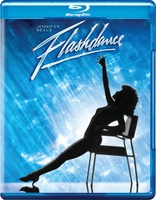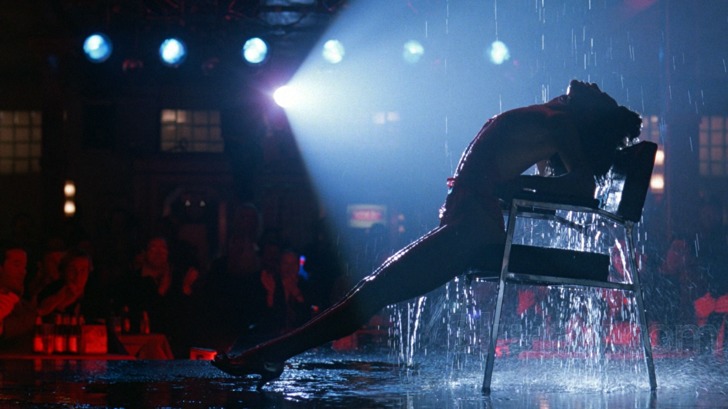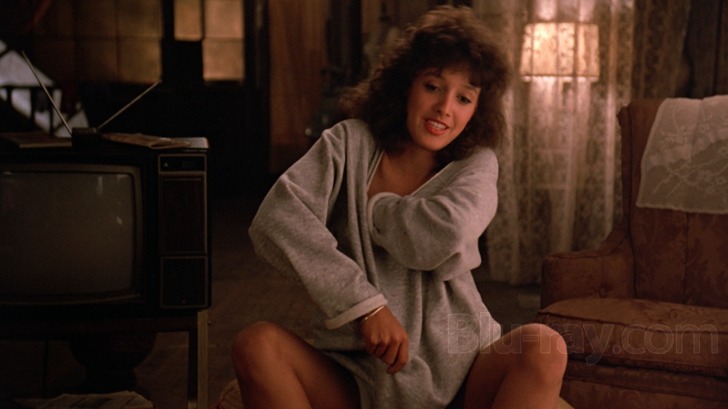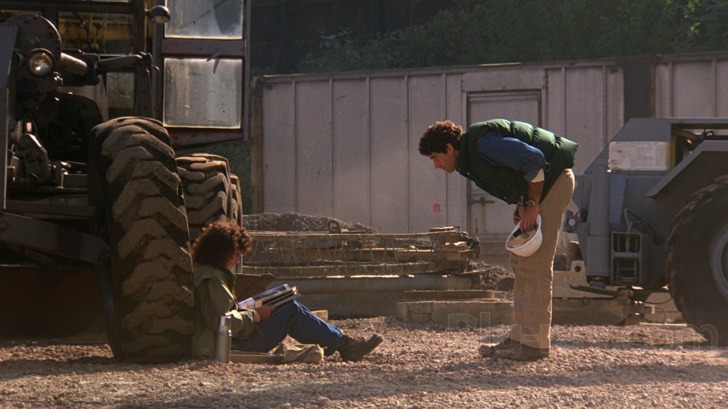Flashdance Blu-ray Movie
HomeFlashdance Blu-ray Movie 
Warner Bros. | 1983 | 95 min | Rated R | Aug 13, 2013
Movie rating
6.4 | / 10 |
Blu-ray rating
| Users | 4.5 | |
| Reviewer | 4.0 | |
| Overall | 4.0 |
Overview
Flashdance (1983)
Alex Owens is a female dynamo: steel worker by day, exotic dancer by night. Her dream is to get into a real dance company, though, and with encouragement from her boss/boyfriend, she may get her chance. The city of Pittsburgh co-stars. What a feeling!
Starring: Jennifer Beals, Michael Nouri, Lilia Skala, Sunny Johnson (II), Belinda BauerDirector: Adrian Lyne
| Romance | Uncertain |
| Music | Uncertain |
| Drama | Uncertain |
Specifications
Video
Video codec: MPEG-4 AVC
Video resolution: 1080p
Aspect ratio: 1.78:1
Original aspect ratio: 1.85:1
Audio
English: DTS-HD Master Audio 5.1 (48kHz, 24-bit)
French: Dolby Digital 2.0
Spanish: Dolby Digital 2.0
Subtitles
English SDH, French, Spanish
Discs
50GB Blu-ray Disc
Single disc (1 BD)
Playback
Region free
Review
Rating summary
| Movie | 4.0 | |
| Video | 4.5 | |
| Audio | 4.0 | |
| Extras | 3.0 | |
| Overall | 4.0 |
Flashdance Blu-ray Movie Review
Just a Steel Town Dancing Queen
Reviewed by Michael Reuben August 14, 2013Beginning with Saturday Night Fever in 1977, American filmmaking briefly reforged the connection between popular music and mass entertainment that had been broken with the decline of musical theater. Fame, Footloose, Dirty Dancing and especially Flashdance are all examples of commercial hits that were also accompanied by best-selling singles and albums as successful as the films themselves. But Hollywood stumbled into this new style of "soundtrack musical" by accident. In the golden age of Rodgers and Hammerstein, shows arrived from Broadway prepackaged with story, songs and sometime even stars already attached. The "soundtrack musical" was different. Characters didn't burst into song to express their feelings, so that songs weren't written to a script (or "book", in theatrical parlance). The songs had to work independently of the film to be suited for radio play (and later, music video), but at the same time they had to serve a purpose within the film. It's no accident that dancing replaced singing in movie musicals after Saturday Night Fever. It was kinetic, it was visually interesting, and it was a lot easier to work into a film script than singing. Still, studio executives remained uneasy with the format, because they didn't have Broadway as a filter to separate the flops from the hits. Saturday Night Fever was made on the strength of John Travolta's popularity. Everything after that was a gamble, usually made against great resistance. Flashdance was one such project. Paramount had so little faith in the film that it hedged its bets by selling off 25% of the rights shortly before release. When a preview audience scored the film highly, Paramount executives accused director Adrian Lyne and producers Don Simpson and Jerry Bruckheimer of fudging the numbers. Polygram Records so underestimated album sales that the record went temporarily out of print shortly after the film debuted. No one expected what Bruckheimer describes in the 2007 documentaries included on this Blu-ray: patrons leaving a theater in Westwood, crossing the street to buy the record, then returning to the theater for a second viewing. During the summer of 1983, the look and the sound of Flashdance were everywhere, as anyone who remembers that year can attest. The film's influence on fashion, music and general attitude was unmistakable. At a mere eighteen years of age, first-time star Jennifer Beals became one of the world's most admired women, because so many female viewers projected their hopes and aspirations onto her character, Alex. (Much the same thing would happen seven years later with Julia Roberts in Pretty Woman, which also told a variation on the Cinderella story.) At least two songs from the soundtrack, "Flashdance . . .What a Feeling" and "Maniac", remain pop standards to this day.

Flashdance is the story of Alex Owens (Beals), a working class girl from Altoona, Pennsylvania, who has moved to Pittsburgh in search of something better. She loves music and wants to dance, but for now she works as a welder in the steel factory owned by Nick Hurley (Michael Nouri). She lives with her dog Grunt in an abandoned warehouse where the rent is cheap and the open space is good for rehearsal. She saves all her money so that, if she can ever work up the courage to apply to the Pittsburgh Conservatory, she will be able to support herself during her time there. At night, though, Alex is one of the dancers at Mawby's Bar, a local steelworkers' hangout, where the entertainment is exotic without being too exploitative. Alex and her fellow dancers—Tina (Cynthia Rhodes), Heels (Durga McBroom) and Margo (Stacy Pickren)—perform sexually charged dance routines, shed some (but not all) of their clothes and mesmerize the mostly male clientele, but they do it with class. At the Zanzibar, by contrast, the oily proprietor, Johnny C. (Lee Ving), has the girls dancing nude, displaying their privates to the customers and collecting "tips" on stage like strippers. He's constantly trolling Mawby's for new recruits. His current target is Alex's friend Jeannie (Sunny Johnson), a waitress who dreams of becoming a champion figure skater. Alex has an elderly mentor, Hanna Long (Lilia Skala), a retired ballerina who sometimes accompanies her to performances at the Conservatory and pushes her to apply, apply, apply, but Alex is intimidated by her lack of formal training and her blue collar background. When she first visits the admissions office, all the other girls are in sleek ballet outfits, while she is wearing work boots and a military surplus jacket. She runs out in a panic. (Ironically, the success of Flashdance would make Alex's outfits fashionable.) New encouragement arrives from an unexpected source. One night at Mawby's, Nick Hurley sees Alex dancing and is smitten. He's even more intrigued when he discovers that she works for him. Overcoming Alex's objections to dating the boss—in today's world, Nick would probably be deterred by fear of a sexual harassment claim—they begin a tempestuous relationship, which helps fortify Alex to audition. (It doesn't hurt that Nick has connections on the local Arts Council, which helps Alex get in the door.) The film's famous climactic sequence is Alex's audition piece, performed to the Oscar-winning song "Flashdance . . .What a Feeling". As a film, Flashdance is defined by sharp contrasts. The rust and wreckage of Pittsburgh's crumbling steel industry contrast with the shimmer and glow of the stage at Mawby's, where Alex nightly disappears into her other world. (And exactly how does a steelworkers' bar manage to maintain a dancing stage with expensive lighting and fixtures that look like they belong in a "members only" club for Wall Street highrollers? Don't ask.) The generosity and decency of Nick Hurley contrasts with the exploitative sleaze of Johnny C., for whom Nick used to steal hubcaps. (How did Nick get rich enough to acquire the factory and still remain a nice guy? Don't ask.) Alex's inventively "free" dancing contrasts with the disciplined ballet that Hanna wants her to study. (How did Alex and Hanna meet? Don't ask.) Alex's aspirations for a better life and an artistic calling contrast with the short-term focus and resignation of the other dancers, as exemplified by Margo's speech near the film's end. And Alex's smoldering dark looks and frank sexuality are an especially sharp contrast—for both Nick and the audience—with the blonde ice queen, Katie (Belinda Bauer), Nick's ex-wife, whose memorable exchange with Alex over a lobster dinner leaves Nick feeling almost like a prize in a contest between two women. None of this is remotely credible as real life, but who cares? Fairy tales aren't supposed to be real life. They bypass credibility to make deeper connections that are more powerful and lasting, which is why they work so well as musicals. As Aristotle first recognized long ago, music is the art form that addresses human emotion most directly. What a feeling indeed.
Flashdance Blu-ray Movie, Video Quality 

Continuing the theme of contrasts, Lyne and cinematographer Don Peterman (Men in Black) shot a movie about artistic aspiration in the gritty urban style pioneered by Lyne's countryman Alan Parker for Fame (1980). Lyne then softened the imagery by dispersing smoke into the air in almost every shot such that, according to editor Bud Smith, there were always a few takes that couldn't be used because the actors were obscured. (Midway through production, the studio panicked and ordered that no more smoke be used, and Lyne posted an assistant to watch for the approach of any studio people, so that the smoke machine could be hidden before they arrived.) The result is an often soft, delicately colored image of a type that has gone almost entirely out of fashion in today's world of digital photography and post-production. Paramount/Warner's 1080p, AVC-encoded Blu-ray is a superb rendition of Lyne's and Peterman's vision, as it was seen by audiences in 1983. The grain and texture of the imagery have been retained without diminishment, but they never become obtrusive (unless one is allergic to even a hint of grain). No attempt has been made to compensate for the original photography's softness with digital tools, which is the correct choice, because the image has fine detail that artificial sharpening or excessive contrast could easily overwhelm. Besides, Lyne and Peterman carefully designed Flashdance for visual contrast between the muted everyday world and the garishly "hyper-real" stage show at Mawby's, with its intense colors and bright lights. A Blu-ray treatment that failed to render both ends of this contrast accurately would not do justice to the film. This Blu-ray does. Blacks are deep and accurate, and shadow detail is properly rendered in places where you're supposed to see it. Minutia of hair, faces, costumes and the rusting Pittsburgh cityscape are readily discernible, even if they don't pop off the screen in every scene (they're not supposed to). The average bitrate of 26.44 Mbps is sufficient for the rapid dancing scenes, primarily because there are more than a few episodes of simple, quiet conversations in between. In any case, I saw no compression artifacts.
Flashdance Blu-ray Movie, Audio Quality 

Flashdance was released in Dolby Surround and has been remixed for 5.1, which is here presented in lossless DTS-HD MA 5.1. As is typical of Paramount's remixes, the approach is conservative and does not attempt to create gimmicky rear channel effects where none are warranted. The stereo separation in the original mix was often effective in placing sounds of such locations as the steel mill to the left or right of characters, and those effects have been preserved. Otherwise, the chief beneficiary of the lossless multi-channel treatment is the historic soundtrack. The songs sound airier and more "opened up" than I have ever heard them before, from the moment Irene Cara's voice comes in over the opening titles. The dialogue is occasionally overwhelmed by Giorgio Moroder's instrumental score, but this has always been the case with Flashdance. The sound mixers understood what was important, and dialogue took a backseat to the beat.
Flashdance Blu-ray Movie, Special Features and Extras 

Paramount has released four DVD editions of Flashdance. The first in 2002 was featureless. A "special collector's edition" in 2007 added the array of features that have been ported over to this Blu-ray; that edition was reissued in 2010 (without the "special collector's edition" label) under the same cover used for the Blu-ray. In between, in 2009, Paramount re-released the featureless disc as part of their "I Love the 80s" series but included with it a limited edition CD of the soundtrack. Some pre-release announcements indicated that the soundtrack CD would also accompany the Blu-ray, but unless there is a retailer special of which I am unaware, that is a mistake. No CD is included. Note that all of the featurettes listed below are essentially part of the same documentary, cut up into segments.
- The History of Flashdance (1080p; 1.78:1; 14:43): Lyne, Bruckheimer, associate producer Lynda Obst, Michael Nouri and actor Kyle T. Heffner (who played Richie the cook and aspiring comic) discuss the origin of the project, although there is reportedly much more to the story than they relate. For example, no mention is made of the involvement of other directors, although Brian De Palma was reportedly attached for a time, before leaving to make Scarface.
- The Look of Flashdance (1080p; 1.78:1; 9:13): The same group, plus editor Bud Smith and costume designer Michael Kaplan, discuss the film's visual style, especially its costumes.
- Flashdance The Choreography (1080p; 1.78:1; 10:10): The important new participant here is choreographer Jeffrey Hornaday. Lyne also discusses the various stunt doubles used to transform Beals into an extraordinary dancer, as well as the "dancing cop" sequence.
- Flashdance: Music and Songs (1080p; 1.78:1; 6:14): Giorgio Moroder and music supervisor Phil Ramone are the key participants here. (Note that Bruckheimer says he always referred to the film as a musical.)
- Releasing the Flashdance Phenomenon (1080p; 1.78:1; 8:53): Bruckheimer, Lyne and others discuss the film's release and its surprising success.
- Teaser Trailer (1080p; 1.78:1; 1:31): Tantalizing.
- Trailer (1080p; 1.78:1; 1:58): The trailer is effective, and it includes some quick cuts of footage that did not make it into the final film. Unfortunately, no deleted scenes appear to have survived.
Flashdance Blu-ray Movie, Overall Score and Recommendation 

Once upon a time, popular music and Broadway musicals moved in sync, but after the Beatles, the Sixties and rock music, popular taste shifted, which I think is the real reason why traditional movie musicals have never again caught on, despite the occasional exception like Chicago. The "soundtrack musical" might have survived to become a perennial, but it suffered from one flaw that studio executives simply cannot tolerate: It didn't have a formula that they could understand. Successful soundtrack musicals usually arrive from unlikely stories that no one "gets" except their creators. When someone tries to "reverse engineer" one of these films from the soundtrack backwards, the result is almost always stillborn (e.g., Alan Moyle's 1980 Times Square). Nothing discomfits the executive suite more than a creative process they can't keep some sort of rein on. (It's not an unreasonable concern; look what Heaven's Gate did to United Artists.) Whether or not Flashdance is to your personal taste, it should be recognized for the marvel it is: a genuine artistic statement produced at just the moment when corporate consolidation was hardening Hollywood's shell against precisely such endeavors. A worthy Blu-ray presentation of an iconic film. Highly recommended.
Other editions
Flashdance: Other Editions

Flashdance
1983

Flashdance
Retro VHS Collection
1983

Flashdance
Remastered | Paramount Presents #4
1983

Flashdance 4K
40th Anniversary Edition
1983

Flashdance 4K
40th Anniversary Edition
1983
Similar titles
Similar titles you might also like

Footloose 4K
40th Anniversary Edition
1984

Staying Alive 4K
1983

Dirty Dancing 4K
35th Anniversary Edition
1987

Saturday Night Fever 4K
45 Year Anniversary | Theatrical Cut / Director's Cut on standard Blu-ray
1977

A Star Is Born
2018

Jailhouse Rock
1957

Step Up
2006

Make It Happen
2008

Make Your Move
2013

Young Man with a Horn
Young Man of Music / Warner Archive Collection
1950

Love Me or Leave Me
Warner Archive Collection
1955

Begin Again
2013

Step Up 2: The Streets
Dance-Off Edition
2008

The Loves of Carmen
1948

Mao's Last Dancer
2009

Cabaret
Reissue
1972

Stomp the Yard
2007

Step Up 3
2010

Crazy Heart
2009

The Rose
1979